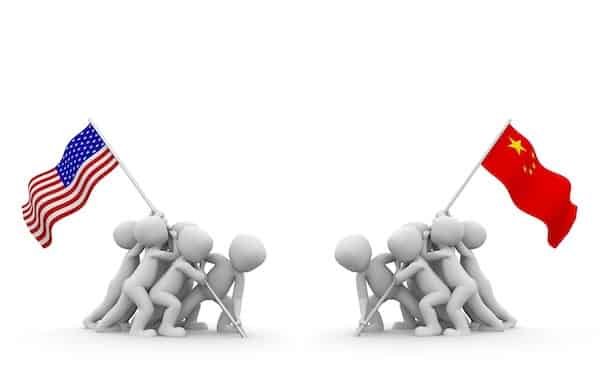by Alan Friedman |
L’semiconductor industry s not usually in the headlines, but recently the global chip shortage, combined with the battle for control of production capacity, have sharpened the rivalry between America and China, which is increasingly virulent, while Europe, unfortunately, is still lagging behind.
President Joe Biden has taken action to increase U.S. manufacturing capacity, while encouraging Asian giants like Samsung to move some of their manufacturing from South Korea to places like Arizona. Biden's approach is muscular, albeit couched in more diplomatic terms than his predecessor.
A case study on the impact of Covid
But what happened? The current global semiconductor shortage is a case study of the impact Covid has had on supply chains and trends in production and employment levels.
Integrated circuits, which use silicon as a semiconductor material, are increasingly critical, but lockdowns due to Covid-19 in 2020 have caused a global shortage.
This has disrupted global supply chains and the production capacity of many industries. Especially, the automotive sector: the biggest companies on the planet, including Ford, General Motors and Volkswagen, were unable to produce their cars because of this sudden shortage. During the lockdown last year, they cut back on their chip orders, usually delivered and managed within a supply chain organized according to a just-in-time philosophy, and then failed to predict how quickly demand would rebound at the end of 2020.
Chipmakers, meanwhile, shifted production to segments that were more convenient for them: laptops, consumer electronics, and data centers, where demand soared during the pandemic. Result: companies have reorganized the production and destination of chips, and this trend is set to continue in the era of 5G, artificial intelligence, and the internet of things. Currently, every single electric vehicle that is assembled contains integrated circuits with a total value of $800. The industry as a whole spends $40 billion a year on microchips. But Apple alone consumes more silicon chips than the entire auto industry. So demand for semiconductors has increased as a result of Covid: the new digital revolution triggered by the pandemic has spurred growth.
The geopolitics of semiconductors
Today four Asian countries produce about 75% of the world's semiconductors: China, Japan, South Korea and Taiwan. Taiwan, in particular, is the largest producer of semiconductors in the world, with the giant Tsmc (the Taiwan Semiconductor Manufacturing Company) holding a market share estimated at around 51%. And although Taiwan is independent from China, Washington is very concerned about the amount of Chinese capital invested in the island, and about the effects that a possible worsening of relations between the two superpowers could have on the ability of SMCC to supply chips to American companies, with special attention to those that produce fighters and planes for the Pentagon. 
That's why many analysts compare the competition for control of global semiconductor production to the space race. The United States today produces only 12 percent of the chips sold worldwide. America's competitive advantage in the industry is engineering, not manufacturing. China, meanwhile, has set a goal of achieving a dominant position in semiconductor manufacturing by 2025. A target it will probably not reach.
Biden's response to chip shortage
Joe Biden's response to the semiconductor shortage and the calls for help from American industry has been swift and decisive. While Trump used the constant threat of new punitive tariffs against China, announcing them via tweets, Biden prefers a more traditional diplomacy and an industrial policy based on a clear discontinuity, based on tax incentives and subsidies to create the right conditions for a growth in domestic production capacity over a longer period of time. Biden also authorized the transit of naval units through the Taiwan Strait. It is a warning to Beijing, and the meaning is clear: America is back in the global game of geopolitics. Biden does not want to threaten China; his goal is simply to reiterate forcefully that Taiwan should not be interfered with and that America is willing to strengthen its semiconductor industry with tax incentives and federal funds. At the same time, the US president is pushing for $37 billion in aid for the industry. In February, he signed an executive order promoting a restructuring of the semiconductor, IT and advanced chip packaging industries. "I will give direction to senior figures in my administration to work with industry leaders to find a solution to the semiconductor shortage," Biden announced in signing the executive order. "Congress has given the green light but we need $37 billion to make sure we have the necessary manufacturing capacity. That's a goal of mine as well. We've seen recently what the consequences of the lack of microchips and semiconductors are: there have been delays in the production of automobiles, which have caused a cut in American workers' hours...we need to make sure these supply chains are secure and reliable," Biden said.
On chips, Europe stands by and watches
But what is the Old Continent doing while Washington and Beijing battle for control of the global semiconductor supply chains? For now, it is watching the tug-of-war between the two superpowers. At the moment, Europe is not a big enough player, and it doesn't count for much. It's worth about ten percent of the world's semiconductor industry, and European automakers are being blindsided just as their competitors were in Detroit. In general terms, there is no doubt that the Biden administration's Asia strategy aims to bring allies together under the banner of democracy, especially when it comes to confronting China. Unfortunately for Washington, some of its biggest friends in Europe and Asia have such deep commercial and financial relationships with the Rising Sun that it might consider them a priority. In the meantime, the history of semiconductors offers us many lessons to learn. And there is also an evolving geopolitical implication. It's all part of a bigger picture: the coming battle for technological supremacy between the two superpowers of the 21st century, the United States and China. A techno-democracy and a techno-autocracy.



















